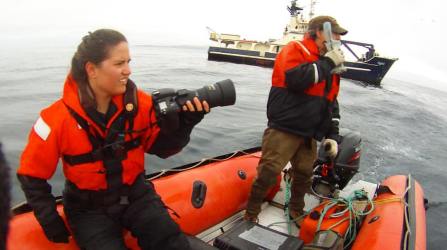
June 19, 2018
Katie Sweeney
Biologist
Well, Steller Watch team, it’s that time of year again! We are gearing up to head out for our summer field season to Alaska to study Steller sea lions. While we are away, we will not be present on our Project Blog or the Talk Forum. Our current workflow will still be live while we are away! We are hoping to be almost complete with this current set of images very soon since we plan on coming back in the fall with a whole new set of images!

We have several Steller sea lion trips happening this summer, very similar to last year: a research cruise to the western Aleutian Islands, a traditional aerial survey, and a resight cruise to the eastern Aleutian Islands and Gulf of Alaska. Unfortunately, this year we are not able to do our field camps. This will be the first time since our field camp effort began a couple decades ago that we will be unable to do field camps (except for in 2006 when field camps were on hold due to a law suit). Other science groups from the Alaska Fisheries Science Center are heading out this summer for field work, as well.
Western Aleutian Island Research Cruise:
This year’s cruise is very similar to last year. We will be on board the U.S. Fish and Wildlife Service’s R/V Tiglax for about two weeks surveying between Attu and Adak Islands. During this trip we will be conducting count surveys by boat, land, and air with our drone. We will also be looking for marked animals at all the sites we visit and visit those sites with remote cameras to collect more images for Steller Watch! We will be doing some work with pups to collect data to help figure out more about pup health in the Aleutian Islands. Finally, there will be a couple whale biologists on board with us to help look for whales in the area, including killer whales.
NOAA Twin Otter Aerial Survey:
Since 2006, NOAA’s Aircraft Operations Center has operated a NOAA Twin Otter for the aerial survey that will go from the Delarof Islands to the western Gulf of Alaska. This means they mostly operate out of Adak Island and Dutch Harbor. We even hope they’ll be able to check out Bogoslof Island, a volcano that erupted for over a year and has more than doubled in size. Will we see Steller sea lions, northern fur seals, and sea birds?
Eastern Aleutian Islands & Gulf of Alaska Resight trip:
We are not able to do field camps this year but luckily we are able to do a resight trip to look for animals that were marked on Ugamak Island, just last year. During this trip, we will just be visiting sites to look for those newly marked one year olds and marked adults beginning around Dutch Harbor and ending in Homer, AK.
A HUGE thank you to those of you who have contributed to Steller Watch! We’ll be back in the fall with many, many more images to share!
I have been a biologist in NOAA Fisheries Alaska Fisheries Science Center studying Steller sea lion population abundance and life history for over 10 years. I am an FAA certified remote pilot and have been flying marine mammal surveys with our hexacopter since 2014. I earned my B.S. in Aquatic and Fishery Sciences at the University of Washington and my Master in Coastal Environmental Management at Duke University.

























You must be logged in to post a comment.